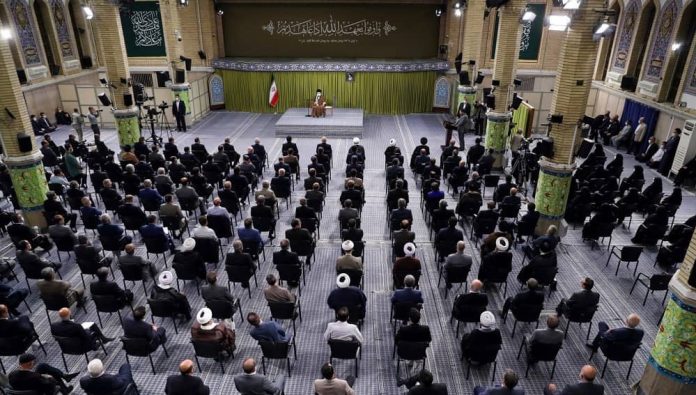Khamenei’s Economic Hypocrisy: From Rhetoric to Reality in Iran

Written by
Farid Mahoutchi
khamenei majlis parliament meeting (1)
FILE PHOTO
Three-minute read
On March 20, 2024, the Iranian regime’s supreme leader, Ali Khamenei, delivered his Nowruz speech. Despite Khamenei’s attempts to twist the truth, his message showcased Iran’s financial calamity due to the regime’s corruption and wrong policies.
“The country’s fundamental weak point is the economy,” Khamenei said, acknowledging the country’s economic crunch. Yet, he contradicted himself by claiming that “Regarding last year’s slogan, ‘controlling inflation and increasing production’ many good actions were taken. Of course, it was not enough.”
Khamenei emphasized the importance of production, stating, “The issue of production is very important. Thus, I emphasize it and expect to see a surge in production this year, and of course, this wouldn’t happen without people’s participation.” He further suggested that the regime should “popularize the economy and increase people’s participation.”
Khamenei’s speech echoed with rhetoric but lacked substance. As Reuters revealed in 2013, Khamenei controls a vast $90 billion financial empire, accumulated through usurping people’s wealth. Yet, he only offers recommendations. In April 2019, the Daily Sabbah quoted US officials as estimating his wealth at around $200 billion. The true extent of his wealth remains one of the state’s most guarded secrets, likely surpassing current estimates.
Besides, Khamenei cloaks his true intention of entrusting the remaining facets of Iran’s economy and the country’s income streams to the Revolutionary Guards (IRGC), under the guise of “popularizing the economy.” Attempts to genuinely popularize Iran’s economy are indeed unattainable, as the country’s resources are monopolized and plundered by the IRGC and Khamenei’s affiliated financial institutions.
For years, Khamenei allowed his goons to devastate Iran’s economy under the pretext of the “private sector.” The terms “private sector” or providing economic opportunities to “people” are euphemisms wielded by Khamenei to signify the Revolutionary Guards (IRGC) and its economic powerhouses, in addition to the paramount conglomerate of the regime’s Supreme Leader. Any business aspiring to wield significant economic influence in Iran must establish connections with the IRGC.
In 2020, amidst the growth and eventual burst of the Stock Market bubble, Ali Khamenei backed his president Hassan Rouhani’s plan, encouraging investment in domestic goods and productive ventures like cooperatives and stock exchanges. Despite warnings from regime economists of an imminent burst, fueled by Rouhani’s government’s methods, some individuals heavily invested, causing the stock market index to soar to 2 million points by July 2020. Yet the bubble growth rapidly burst, leaving many Iranian investors destitute, while allowing Rouhani’s government to compensate for its budget deficit and the IRGC to sell shares of imaginary enterprises.
So, when Khamenei speaks of “economic opportunities” and “popularizing the economy,” he implies further plundering and increased poverty for Iranians.
“The cost of fruits and vegetables has risen by 100-200% over the past two years, while the prices of white and red meat have surged more than fourfold compared to summer 2021,” reported the state-run Setareh Sobh Daily on March 11, 2023.
Recent reports indicate that red meat prices have surged by 82% compared to the previous year, reflecting the ongoing challenges faced by Iranian consumers. The inflation rate for a basket of essential daily needs is nearly 40%, while overall inflation for retail food prices continued to stand north of 50% throughout the year.
Ali Khamenei delivered his annual speech on March 21. Aside from his bogus claims of victory and blaming Iran’s social and economic crises on “the enemies,” Khamenei’s speech was an obvious testament to the regime’s deficiencies and crises.#IranRevoIutionhttps://t.co/ua4L7bXlWW
— NCRI-FAC (@iran_policy) March 24, 2023
Despite increased oil exports and circumventing sanctions, the Iranian regime failed to curb inflation. The national currency, the rial, remains weak against the US dollar, hovering around its all-time low. This economic pressure has led to protests and unrest, highlighting the profound impact of high prices on the daily lives of Iranians.
Seeing his regime’s downfall on the horizon, Khamenei embarked on a dangerous gamble following the October 7 attack, using the global focus on regional disputes to oppress Iran’s restive society. However, changing times and tides have turned against Khamenei, and the “head of the snake” needs every penny to fund and fuel its terrorist proxies and chaos across the region.
Iran’s economic downturn does not have a financial solution, as the problem stems from the regime.
During Mahmoud Ahmadinejad’s presidency, the regime had ample time and prime opportunity to tackle Iran’s economic woes, amassing approximately $900 billion from oil revenues. However, instead of investing in the nation’s prosperity, the bulk of these funds were wasted on supporting terrorism, developing weapons of mass destruction, and importing goods, consequently exacerbating unemployment, liquidity, and inflation, and hampering national production.

